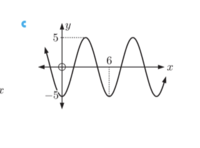Hi! Please help!

We have to construct a formula for it,using a(cos(bx-c))+d The answer is -5(cos (pi/3)x). Can i assume that 6=angle in here? Is it possible to construct the formula if i assume that it shifts horizontally?Apologies for so many questions. I might make the same kind of mistakes if i am not clear about the concept ?
Thank you! Really a big thank you to the teachers who have helped me through the questions!

We have to construct a formula for it,using a(cos(bx-c))+d The answer is -5(cos (pi/3)x). Can i assume that 6=angle in here? Is it possible to construct the formula if i assume that it shifts horizontally?Apologies for so many questions. I might make the same kind of mistakes if i am not clear about the concept ?
Thank you! Really a big thank you to the teachers who have helped me through the questions!
Last edited:
